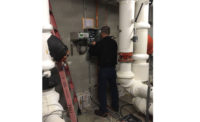 Two years after contaminated cooling towers led to a Legionnaires’ disease outbreak in Edinburgh hospitals, the message about proper maintenance is more important than ever.
Two years after contaminated cooling towers led to a Legionnaires’ disease outbreak in Edinburgh hospitals, the message about proper maintenance is more important than ever.
According to the HSE, 90 percent of Legionella outbreaks have their root causes in failures to identify risk or to put in place effective schemes of control to deal with risks.
There are a number of factors that cause these risks, including changes in process, staff changes, intermittent use of plant, and of particular relevance in the summer, unusual weather conditions. One of the major causes, however, is a departure from planned maintenance and cleaning schedules.
It is essential water storage tanks are maintained in order to keep the environment inhospitable to Legionella. Some of the ways to do this include: ensuring the amount of water stored is kept to a minimum by downsizing tanks; the installation of delayed action float valves to reduce volumes in existing tanks and improve water quality; and isolating twin tanks systems when possible.
Where mains volume matches demand, water storage can sometimes be removed altogether, but this is not usually the case within a hospital scenario. In general, if tanks are used, they must be maintained and well insulated.
Any tanks not being used must be decommissioned and removed along with associated pipework, because stagnant water supports Legionella growth. Cold water storage tanks should be cleaned periodically and water drained from hot water cylinders to check for debris or signs of corrosion.
When designing a system in the first place, short and direct pipework is preferential and, along with any tanks, this pipework must be adequately insulated. Choose materials that do not encourage the growth of Legionella, such as copper, and prevent contamination by fitting lids and insect screens.
Cooling towers are often the root cause of widespread Legionella outbreaks, such as in Edinburgh in 2012. The pack/fill material, which constitutes the majority of the wetted surface area within a cooling tower system, is one of the main areas where scale, debris, and biofilm are likely to accumulate.
Danger Zone
Usually housed in the most inaccessible part of the cooling tower, inspection of the pack to monitor physical condition is difficult. Often, the pack may appear clean superficially, but closer internal examination identifies extensive fouling and scale deposits. Current figures suggest that probably only 50 percent of cooling tower users regularly remove packs, even when they have certificates of cleaning and disinfection in accordance with the HSE’s Approved Code of Practice L8, as risk assessments often do not consider pack removal in sufficient detail.
New cooling towers should be designed so that the pack can be removed easily for inspection and/or cleaning. Access hatches enable towers with sectional packing or pack in baskets to be removed. Towers with hanging fill pack often have removable sides that permit some of the pack to be removed with the rest cleaned in situ.
The design and construction of older towers, however, is extremely varied, ranging from large wooden towers to small towers of solid construction. In many cases dismantling or partial dismantling of the tower will be necessary to enable the pack to be removed.
The primary method used to control the risk from Legionella is water temperature control and, in the case of a cold water system, ensuring that the system is running properly will contribute to cooling. Any system that takes in air from the outside is at risk from clogging caused by airborne particulates. Reducing this clogging is achieved by ensuring filters are clean and, ideally, stopping debris before it even enters a system.
Air intake screens prevent airborne debris from affecting the efficiency of HVAC equipment and improve laminar airflow, diffusing air across the inlet which enhances cooling properties. The knock-on effect of this approach is that maintenance tasks can be reduced.
A study on a cooling tower using air intake screens in the U.S. showed water at 1°C lower at the sump following the introduction of the screens — cooler, in fact, than the system had been designed to operate at. In addition, efficiency of the system was improved by an estimated 5 percent. Across a number of cooling towers, this would contribute to big savings in energy bills, along with payback for the equipment in around 18 months.
Colder conditions and a reduction in the amount of airborne debris reduced the organic load in the system, improving the efficiency of water treatment chemicals, with overall maintenance time and effort cut by more than 25 percent.
The spread of Legionella should be taken seriously in any application, but in the hospital environment, with those most vulnerable to infection in abundance, shortcuts in maintenance are not an option. Through proper cleaning and inspection, plus specialist equipment, risk can be reduced dramatically, stopping this potentially fatal disease in its tracks.
Content for the European Spotlight is provided courtesy of Refrigeration and Air Conditioning Magazine, London. For more information, visit www.racplus.com.
Publication date: 10/6/2014
Want more HVAC industry news and information? Join The NEWS on Facebook, Twitter, and LinkedIn today!








